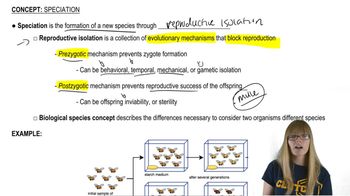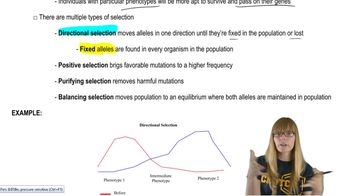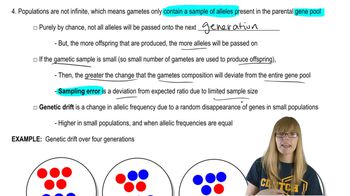Table of contents
- 1. Introduction to Genetics51m
- 2. Mendel's Laws of Inheritance3h 37m
- 3. Extensions to Mendelian Inheritance2h 41m
- 4. Genetic Mapping and Linkage2h 28m
- 5. Genetics of Bacteria and Viruses1h 21m
- 6. Chromosomal Variation1h 48m
- 7. DNA and Chromosome Structure56m
- 8. DNA Replication1h 10m
- 9. Mitosis and Meiosis1h 34m
- 10. Transcription1h 0m
- 11. Translation58m
- 12. Gene Regulation in Prokaryotes1h 19m
- 13. Gene Regulation in Eukaryotes44m
- 14. Genetic Control of Development44m
- 15. Genomes and Genomics1h 50m
- 16. Transposable Elements47m
- 17. Mutation, Repair, and Recombination1h 6m
- 18. Molecular Genetic Tools19m
- 19. Cancer Genetics29m
- 20. Quantitative Genetics1h 26m
- 21. Population Genetics50m
- 22. Evolutionary Genetics29m
21. Population Genetics
Allelic Frequency Changes
Problem 1e
Textbook Question
Population geneticists study changes in the nature and amount of genetic variation in populations, the distribution of different genotypes, and how forces such as selection and drift act on genetic variation to bring about evolutionary change in populations and the formation of new species. From the explanation given in the chapter, what answers would you propose to the following fundamental questions?
How do we know when populations have diverged to the point that they form two different species?
 Verified step by step guidance
Verified step by step guidance1
<span>Step 1: Understand the Biological Species Concept, which defines species as groups of interbreeding natural populations that are reproductively isolated from other such groups.</span>
<span>Step 2: Identify reproductive isolation mechanisms, which can be prezygotic (before fertilization) or postzygotic (after fertilization), preventing gene flow between populations.</span>
<span>Step 3: Examine genetic divergence, where significant genetic differences accumulate between populations, often due to natural selection, genetic drift, or mutation.</span>
<span>Step 4: Consider morphological and ecological differences, as these can indicate adaptation to different environments and niches, supporting the idea of speciation.</span>
<span>Step 5: Use molecular data, such as DNA sequencing, to assess genetic differences and phylogenetic relationships, providing evidence of divergence and speciation.</span>
Recommended similar problem, with video answer:
 Verified Solution
Verified SolutionThis video solution was recommended by our tutors as helpful for the problem above
Video duration:
1mPlay a video:
Was this helpful?
Key Concepts
Here are the essential concepts you must grasp in order to answer the question correctly.
Speciation
Speciation is the evolutionary process through which populations evolve to become distinct species. This occurs when genetic differences accumulate between populations, often due to reproductive isolation mechanisms such as geographic separation or behavioral differences. Understanding speciation is crucial for determining when two populations have diverged sufficiently to be classified as separate species.
Recommended video:
Guided course

Speciation
Genetic Variation
Genetic variation refers to the diversity of alleles and genotypes within a population. It is essential for evolution, as it provides the raw material for natural selection to act upon. By studying genetic variation, population geneticists can assess how populations adapt to their environments and how these changes contribute to the divergence of species.
Recommended video:
Guided course

Genomic Variation
Reproductive Isolation
Reproductive isolation is a key mechanism that prevents different species from interbreeding. It can occur through prezygotic barriers, such as temporal or behavioral differences, or postzygotic barriers, like hybrid inviability. Identifying the presence of reproductive isolation is critical for determining whether two populations have diverged into separate species.
Recommended video:
Guided course

Speciation

 5:58m
5:58mWatch next
Master Natural Selection with a bite sized video explanation from Kylia Goodner
Start learning




